Marshrutka: Difference between revisions
GAZelle pic |
|||
| Line 6: | Line 6: | ||
[[File:Marshrutka kiev 2.jpg|thumb|250px|Interior view of a typical ukrainian Bogdan marshrutka.]] |
[[File:Marshrutka kiev 2.jpg|thumb|250px|Interior view of a typical ukrainian Bogdan marshrutka.]] |
||
[[File:Shevchenko University.jpg|thumb|250 px|A marshrutka BAZ-2215 Delfin. This minibus in [[Kiev]] is mostly replaced by bigger buses. [[Kiev]],[[Ukraine]]]] |
[[File:Shevchenko University.jpg|thumb|250 px|A marshrutka BAZ-2215 Delfin. This minibus in [[Kiev]] is mostly replaced by bigger buses. [[Kiev]],[[Ukraine]]]] |
||
[[File:Petrozavodsk traffic microbus.jpg|thumb|250 px|A yellow GAZ-3221 [[GAZelle]] marshrutka on duty in [[Petrozavodsk]]]] |
[[File:Petrozavodsk traffic microbus.jpg|thumb|250 px|A yellow GAZ-3221 [[GAZelle]] marshrutka on duty in [[Petrozavodsk]]. Note the passengers occupying seats right next to the driver - cabin design typical for [[truck]]s which "GAZelle" family is an example.]] |
||
[[File:A typical Central Asian marshrutka.jpg|thumb|250px|A Central Asian Mercedes-Benz T1 series marshrutka.]] |
[[File:A typical Central Asian marshrutka.jpg|thumb|250px|A Central Asian Mercedes-Benz T1 series marshrutka.]] |
||
[[File:Collage of different coloured marshrutkas in Bishkek.jpg|thumb|250px|In Central Asia, marshrutkas exist in a variety of colours, yet are fairly consistent in model.]] |
[[File:Collage of different coloured marshrutkas in Bishkek.jpg|thumb|250px|In Central Asia, marshrutkas exist in a variety of colours, yet are fairly consistent in model.]] |
||
Revision as of 20:28, 2 December 2012
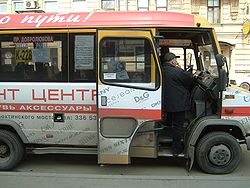
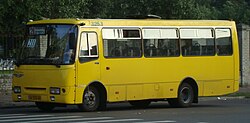



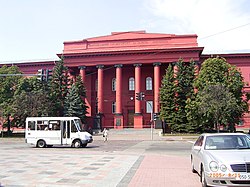
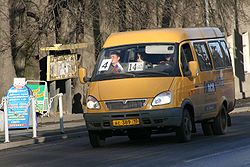



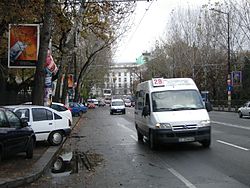

Marshrutka (Cyrillic: маршру́тка [mɐrˈʂrutkə]), from marshrutn[oy]e taksi routed taxicab, is a form of public transportation such as a share taxi for the countries of CIS, the Baltic states, Bulgaria, Georgia and Ukraine. The role of the modern marshrutka is theoretically similar to the share taxi, that use minibuses in other countries except that all implementations of marshrutka do allow standing capacity.
But in fact (in Kiev (Ukraine) and probably not only here) marshrutkas evolve into just "everybody pays" fast going buses. They can be small, medium-sized, and sometimes big, with higher fare (price) than in ordinary municipal buses, and the main thing: with less obligations to carry invalids, pensionaries etc. for free, than ordinary buses. And this is the reason why there are much more marshrutkas in the city than ordinary buses. The word "taxi" is needed just to answer the question why they have no as much free-ride obligations, as ordinary buses, which are usually "full of free riders", are unprofitable and bring economical loss. Interesting fact: in 1990s when local authorities temporarily lost their ability to finance city bus work, the bus drivers just installed in their buses windows tablets with inscription "Taxomotor" and that just meant that every passenger has to pay the fare.
So, now marshrutkas are public route microbuses, middle-size buses and sometimes big buses which go usually faster then ordinary buses and more frequently, but don't take month abonent tickets and take not more then one free passenger per one marshrutka.
Stopping marshrutka in the city out of established stops comes out of practice, being unreasonable because of large amount of passengers and high frequency of the stops.
Etymology
The Russian and Ukrainian word "маршрутка" is the colloquial form for "маршрутное такси", which literally means "routed taxi(cab)" ("маршрут" referring to a planned route that something follows, and "такси" meaning "taxi(cab)"). The word "маршрут" is from the German word "Marschroute", which is composed of the word "Marsch" (a walk, march) and "Route" (route).
History
Early days (pre-1992)
"Route taxicabs" were introduced in Moscow for the first time in the USSR in 1930s, operated by ZiS-101 limousines. Unlike ordinary taxicab using the taximeter, routed taxicab rides were paid per zones, like trams, buses and trolley buses; the fare was lesser than in ordinary taxis, but higher than in large-scale public transports. Unlike ordinary taxis where a passenger could enjoy a private ride, the routed taxicab would also pick up and drop passengers along its route.
Moscow was not the only city operating routed taxis, other large Soviet cities also organized these. For example, in Gorky, there was a routed taxi line between Sormovo and the Nizhny Novgorod Kremlin. As of 1939[update], the full fare was 3½ roubles; a similar service cost 1 rouble with a bus, or 50 kopecks with a tram.[1]
During the Great Patriotic War, as cars were requisitioned by the Army, routed taxi services were ceased. It was only by 1950s that these were reintroduced in most cities where they were used before the war. The ZiS-110 and GAZ-12 cars were widely used in this role until mid-1960s.
There were interurban services of routed taxicabs, too. For example, Moscow-Yalta route was operated in summer season taking 2 days, with a night stop in Belgorod.
In 1960s, minibuses (RAF-977) and small buses (PAZ-652) became common as routed taxis. The routes were operated at municipal level, thus the quality and concept varied greatly between regions. The fare gap between buses and routed taxicabs lessened. For example, in Moscow the standard bus fare was 5 kopecks, and minibus fare was 15 kopecks with most routes; in Gorky a regular bus ride cost 6 kopecks, and routed taxi ride was 10 kopecks.
Later, RAF-977 minibuses were replaced by the updated model, RAF-2203 Latvija. Eventually, practically all marshrutkas became RAF-2203 Latvija; many people even referred to Marshrutka as "Latvia".
Marshrutka boom (1992–2000)
The introduction of market economies greatly changed the supply of transportation in the urban population in the CIS. The demand for faster and more versatile public transit came to be fulfilled dramatically, while the demand for the underfunded municipal transportation system dropped; people are willing to pay premium for better service. Although existing buses (like Ikarus, LAZ, PAZ, RAF, and KAvZ, as well as irregular imported used minibuses), obtained on a secondary market, had been used by entrepreneurs as a back-up on the busiest routes since the early 1990s, it wasn't until the auto manufacturer GAZ rolled out the first mass produced Russian minibus, GAZelle, that the modern system took shape.
GAZelle was an instant hit. The cheap, easy-to-repair, and lease-friendly passenger minibus with a capacity of twelve seated passengers was exactly what entrepreneurs needed. An initial investment of around US$8,000 could be paid off in less than a year given some luck, so a lot of individual entrepreneurs entered the market, as well as some larger companies. At this point in time, licensing for public transportation in particular was not required. The vehicle only had to pass annual safety check-ups, which were relatively easy, since local authorities trusted GAZ cars. Moreover, the GAZelle could be easily equipped to run on natural gas.
During this period, most marshrutkas followed already well-established public transit routes.
Modern days (2000–present)
Witnessing the success of privately owned public transportation led to some reaction from the society. Local authorities responded by toughening safety and licensing requirements—like mandatory free transportation of a certain number of disabled passengers upon request and "package deals" in route licensing—tying the privilege to drive on a lucrative route to the chore of driving several not-so-profitable ones. The market became dominated either by large companies or by unions of owner-operators of individual minibuses. Some of municipal public transportation companies entered the business, and prices dropped due to increased competition.
Another consequence was a massive response from car and bus manufacturers. Old manufacturers introduced smaller, more manoeuvrable models (like PAZ or KAZ) and started licensed assembly of minibuses (KrAZ started assembling Iveco minibuses). Diesel-engined models in the form of the new Isuzu Bogdan, Tata Etalon and others have seen immense popularity. The capacity also grew from fifteen sitting passengers to jam-packed small buses of fifty, and the busiest routes in major cities now use full-size privately owned buses operating at the same price with municipal companies. The original GAZelle saw a few official modifications to its body, length and passenger capacity to better serve buyer demands, including models featuring diesel engines.
Russia, Ukraine, and Belarus
Russia
In Russia, in Moscow and St. Petersburg, GAZelle, Mercedes Sprinter, and Ford Transit vans are usually used as route taxis. The GAZelle and PAZ-3205 are widely used as a marshrutkas in other Russian cities, although in eastern parts the Japanese minibuses like Toyota Hiace are more popular. Route taxis congregate at train stations, metro stations, and transfer points at the end of tram and trolly bus routes. In St. Petersburg the route is identified as "Kxxx" with "xxx" being the number of the bus, tram and trolley bus routes being followed and "K" standing for the Russian word for "commercial" (коммерческий, kommerchesky). There are routes travelled solely by route taxis — cross-city routes connecting termini of the metro. Usually, the route taxi will not depart of the end point of a route until all seats are occupied. The taxi will skip stops if they are not requested and (if operated with a GAZelle or similar) by-pass hailing riders until it has empty seats. The fare is commonly one and a half or twice the fare of a regular bus.
The appeal for the route taxi passenger is officially considered to be a faster ride in less crowded conditions than regular transport; the taxi routes that follow cross-city routes are most often the fastest way to travel across the city. However, collapse of municipal transport services in many cities makes it absolutely impractical to commute without the help of marshrutkas at all.
In Moscow, for example, the average cost for one route is 25 roubles (equals 0.75 euro) (2011 year).
Ukraine

In Kiev, Ukraine, the Bogdan A091 and A092 buses are the most common route taxi which can be found running around the city, while the Etalon bus serves on the lower ridership route. In Kiev, the marshrutka is more popular and the fare is a bit more expensive than the regular public bus. Hail and Ride is possible regardless of the designated bus stop, but generally this is up to driver's final decision (NB: State Automobile inspection (ДАІ) doesn't allow to take passengers outside from the bus stops along the city routes). As of now[when?], marshrutkas in Kiev do not require ticket-perforating, although a passenger can ask for a ticket when paying the fare, but there is no staff working to randomly check the tickets as on a regular bus (although the traditional hole punch still remains on existing vehicles). Outside of Kiev it is not unusual to find marshrutki that are secondhand Western European minibuses or converted vans. Often they still have all the original paintwork advertising the former owner's business.
Etalons and Bogdans usually have a conductor on board selling the tickets. In the GAZelle or converted van, the fare is paid directly to the driver (who, if reckless enough, might count it while speeding off the stop), either upon pickup or departure of the passenger, with a note or sticker posted to indicate the driver's preference. It is common etiquette for passengers to relay the fare of fellow passengers to the driver, and the possible change backwards.
Belarus
In Minsk, Belarus, the fleet of vehicles is same as Russia, consisting of Mercedes Sprinter, and Ford Transit.
Eastern Europe
Armenia
In Yerevan, Armenia, marshrutkas (Armenian: մարշրուտկա maršrutka or երթուղային տաքսի ert’uġayin tak'si) cost the same as larger buses (100 AMD in 2011), with the fare being paid when the passenger exits. There are no tickets issued. Marshrutkas can be hailed anywhere along their route, though they do have specific stops, and riders can exit at any point if the driver is willing to pull over. While the law requires that marshrutkas stop only at designated stops while on major streets, compliance with this law depends on the individual driver and the degree of police enforcement at any given time.
Georgia
In Tbilisi, Georgia, marshrutkas ("მარშრუტკები" marshrutkebi or "სამარშრუტო ტაქსები" samarshruto taksebi) vary in cost from 50 tetri to 80 tetri. Up to 2011, all marshrutkas in Tbilisi had a common fare of 50 tetri, however after introducing new, air-conditioned vehicles, the price went up. Marshrutkas stop upon passengers' request. There are no specific stops where the driver has to do so. In most Marshrutkas, the driver is paid in cash. In some newer vehicles, the passengers have to use fare cards.
Romania
In Romania, where they are called "maxi-taxi", marshrutkas supplied the need of affordable public transportation in smaller towns when some local administrations dismantled the expensive community-owned systems of buses. In Bucharest maxi-taxis existed between 2003 and 2007 when the city-owned RATB temporary lost the right to maintain suburban commuter buses which linked main city with the villages around it. On the Black Sea shore, it is very common to travel from Constanţa or Mangalia to the resorts on a maxi-taxi, especially in those resorts where the competing train service is far from the beach and/or lodging facilities. In Romania were racing from most city, is strong competition and a price cheaper than trains.
Moldova
In Moldova, rutieras (known in Russian as marshrutkas) run all over the capital and to most large cities in the country. Most rutieras are white and have only the roof vent and front windows for airflow. Rutieras usually seat around 16 people with space for another six to ten to stand while holding railing.
Bulgaria
Bulgarian marshrutkas are customized passenger vans. They have been modified to include large windows in the back, rails and handles. In some cases, seating has been modified — popular routes carrying more passengers typically have more standing space.
Sofia's marshrutka system is considerably developed and has existed since the late 1980s, offering many routes crossing through the city centre, communicating with outer suburbs and nearby villages. The Sofia fleet includes such models as the Peugeot Boxer, Citroën Jumper, Ford Transit, Iveco Daily and Renault Master. Other cities have adopted a similar system and models available vary from city to city.
Similar to public transport, they operate along numbered routes around the city and have a fixed fare (1.50 leva in Sofia, equivalent to €0.75 as of 2008); the fare is paid upon getting in. Marshrutkas are not obliged to stop anywhere on the route, although there are popular spots where they do slow down. Marshrutka drivers are asked to stop and pick one up in a taxi-like manner; the getting-off is arranged with the driver, often by just standing up and approaching the door. Sometimes the driver will ask for consent to veer off the charted path to avoid a traffic jam or roadworks.
Marshrutkas are commonly white, although their colour can vary, and they are often partially covered in advertising. There are about 50 marshrutka lines in Sofia alone;[2] the lines being operated by separate private companies. About 10 lines operate in Plovdiv.[3]
The Baltic states
Latvia
Historically, marshrutkas were a common means of transport in larger cities of the Latvian SSR, the RAF-2203 was the only minibus used for this purpose.
In today's Latvia, marshrutkas are still in service in a variety of cities – mostly in Riga, but also in Daugavpils, Liepāja, Jelgava, Jūrmala, Rēzekne and elsewhere. They are mainly used as public transportation within city limits, but sometimes their routes extend outside city limits (e.g. from Riga to Jūrmala). Marshrutkas were and are still widely used, with travelers themselves explaining that the marshrutkas are a much faster way of public transportation than buses or trolleybuses[citation needed] (sometimes also trams, but that is disputed[who?]).
The main operators in Riga are KORT, Blands and Rīgas Taksometru Parks (RTP). KORT is the biggest marshrutka operator in Riga. It (and also the other two) owns white Mercedes-Benz Sprinter buses, yellow Renault Masters (mostly to RTP, small number of them also red), and white GAZelle buses. KORT is sometimes criticized by locals for being the first of the three marshrutka operators to raise the ticket price for a ride, such as when city-owned Rīgas Satiksme raised its ticket prices for other modes of public transport on 1 April 2008.
Blands is the second operator of marshrutkas in Riga, and was the last to raise its ticket price in 2008. It uses the same buses as KORT.
RTP's routes were usually going out the city from their main station in Riga's city center, next to Origo supermarket, e.g. Riga to Ulbroka, Riga to Jūrmala, Riga to Kadaga (near to Ādaži). From January 1, 2009, RTP has closed most of their routes due to financial reasons.[4]
The prices of the tickets (March 12, 2009): KORT - 0.50 Ls Blands - 0.40 Ls RTP - 0.45 Ls (Rīga-Imanta), 0.50 Ls (Rīga-Bolderāja).
Lithuania
In Lithuania, marshrutkas have been in service in a variety of cities since the end of the 1980s – mostly in Vilnius and Kaunas, but also used in Klaipėda, Šiauliai and elsewhere. They are mainly used as public transportation within city limits, but sometimes their routes extend outside the city limits. Marshrutkas were and are still widely used, with travellers themselves explaining that the marshrutkas are a much faster way of public transportation than buses or trolleybuses. But nowadays marshrutkas are declining due high cost of travel(3 Lt)and municipal public transport: buses and trolleybuses. In some municipalities, e. g. Panevėžys city marshrutkas are banned.
Estonia
In Estonia, marshrutkas ("Marsruuttakso" in Estonian) are widely used in cities of Tallinn and Tartu. In case of Tallinn they are mostly used on routes connecting city to small town's around like Saku, Saue and Kose where most people have cars and demand for public transport is lower but many departure times are very useful. Late evening departures may have higher fares because local trains and other means of transportation will not run any more. In late evening marshrutkas are also good choice for suburbs were bus services end around midnight and some marshrutkas are going hour or two later through. Marshrutkas are widely used in Tartu on all routes and have much better point because city population is only quarter of Tallinn.
Central Asia
In Central Asia (at least in Uzbekistan, Kazakhstan and Kyrgyzstan), standing room is allowed on marshrutkas. Indeed, drivers will often encourage passengers to board the marshrutka and cram together until there is physically not enough space for another passenger to board; in such a case, once a passenger exits the marshrutka, the driver will stop for others and allow them on until it is full again. Marshrutkas may be boarded at bus stops, but will usually stop other places if hailed, and often won't stop at bus stops unless a passenger requests an exit or a prospective passenger hails the marshrutka. Passengers may request to exit at any point, but may have to wait until the driver deems that it is convenient to stop.
The typical Central Asian marshrutka is usually a white minibus branded "Mercedes", though may come in any number of colours, sometimes used to distinguish a specific route. The models most commonly used have a vent in the roof that may be opened by passengers if the atmosphere inside the marshrutka becomes too stuffy. Though not the norm, other vehicles are used as well; for example, all 149 marshrutkas in Bishkek are Shaolin Citybuses. In Osh, an older, shorter model of vehicle which doesn't lend itself well to standing room is also used for some routes.
The normal price per fare in Bishkek is 8 som (about 20 cents), and there are no transfers. Some routes may charge as much as 15 som per fare, such as marshrutkas heading to Dordoy Bazaar, which is on the outskirts of the city. In Almaty, on 3 January 2008, bus fare was increased from 40 tenge to 60 tenge (about 40 cents). Prices range throughout Central Asia, dependent on whether it is a city or village, the local cost of living, distance covered by route, and government policy.
See also
Notes
- ^ Soviet rouble was since then denominated twice, in 1947 and 1961.
- ^ "Маршрутки - sofiadnes.com". sofiadnes.com<!. Retrieved 2009-11-07.
- ^ "Община Пловдив - България - Маршрутки". Plovdiv.bg. Retrieved 2009-11-07.
- ^ "Rīgas taksometru parks". Rtp.lv. Retrieved 2009-11-07.
